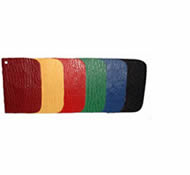Shark leather
Jaws, the movie. Scenes flashing in the mind. Okay, back to reality, people, thank you.
It's a fact that people get killed by lightning strikes than by shark attacks. Human deaths due to direct shark attack are much lesser than what we think.
Another interesting fact. Sharks have two senses that many animals do not have:
- Electroreception: The Ampullae of Lorenzini are small pits in the head that detect electricity. The shark has the greatest electricity sensitivity known in all animals. This sense is used to find prey hidden in sand in bottom feeding sharks, by detecting the nerve impulses. They can track these things from the top around a mile away, and it not only senses prey, it can sense other things as well! It is almost like having a small camera in the shark's eye, but not really. It can sense that if there is a prey, or if it is a predator, or if it is just a spectator watching it.
- Lateral line - This system is found in most fishes, including sharks. It is used to detect motion or 'sound' in the water. The shark uses this to detect other organisms moving, especially wounded fish. The shark can 'hear' frequencies in the range of 25 to 50 Hz using this sense.
Stuff to Know
Animal: |
The Shortfin Mako shark (Isurus oxyrinchus). The Sandbar shark (Carcharhinus plumbeus). The Tiger Shark (Galeocerdo cuvier). |
Maximum size & weight: |
The Shortfin Mako reaches 400 cm (157 in) and the heaviest recorded weight is 505.8 kg (1,115 lbs). The Sandbar shark reaches 250 cm (98.42 in) and the heaviest weigh 117.9 kg (260 lbs). The Sandbar shark reaches the maximum The Tiger Shark can max out at 7 meters (23 feet) and can weigh up to a ton (2,200 lbs)! This one is the notorious eater that has been found to have license plates and old tires in its gut! |
Maximum age: |
The maximum recored age of the Shortfin Mako is 25 years. The maximum age of the Sandbar shark is 30 years. Tiger Shark can reach up to 50 years! |
Protected? |
Not protected, but world population threatened by shark-fin fishing. There's a lot of people who really like this shark-fin soup. There's no knowing until it's tried .. er, tasted. |
Where it lives in the wild |
The Shortfin Mako can be found in the Western Atlantic: Gulf of Maine to southern Brazil, including the Gulf of Mexico and Caribbean. Eastern Atlantic: Norway to South Africa, including the Mediterranean. Indo-Pacific: East Africa to Hawaii, north to Primorskiy Kray (Russian Federation), south to Australia and New Zealand. Eastern Pacific: south of Aleutian Islands and from southern California, USA to Chile. The Sandbar shark can be found Western Atlantic: southern Massachusetts, USA to southern Brazil; also Gulf of Mexico, Bahamas, Cuba and south and west Caribbean. Eastern Atlantic: Portugal to Democratic Republic of the Congo, including the Mediterranean. Indo-Pacific: scattered records ranging from the Red Sea, Persian Gulf and East Africa to the Hawaiian Islands. Eastern Pacific: Revillagigedo and Galapagos islands. The Tiger Shark have been reported sightings in Thailand and the Philippines. Information from the experts states that Tiger Shark can be found circumglobal in tropical and temperate seas. Western Atlantic: Massachusetts, USA to Uruguay, including Gulf of Mexico and the Caribbean. Eastern Atlantic: Iceland to Angola. Indo-Pacific: Red Sea and East Africa to Hawaii and Tahiti, north to southern Japan, south to New Zealand. Eastern Pacific: southern California, USA to Peru, including the Revillagigedo, Cocos, and Galapagos islands. They are also known to be highly migratory. |
Where is it farmed? |
Sharks are not farmed but are caught in the sea. Wouldn't it be great if there could be a shark aquaculture, so that the shark could be conserved at the same time meet the demands of the consumers? Food for thought, eh? |
Dangerous to humans? |
Most of the time, no. Just don't bleed in the water and thrash. |
Afraid of humans? |
Not at all! |
People injured yearly |
There are less than 100 reported injuries from shark each year, compared to 300 people injured by lighting. There's not much of a chance of getting injured by a shark. |
People killed yearly
by |
Worldwide, sharks on average kill less than 10 people each year (3 in 2002). Now compare that to elephants killing 200 people per year. Compare that again to 73 people killed by lightning in the USA. Now that's reassuring, don't you think. |
Is meat edible? |
Yes. Shark meat is also made part of the meal "fish and chips". |
Taste of meat |
Handled properly, taste good (like swordfish). If not, it starts spoiling and begins to smell like amonia. |
Living habits: |
The Shortfin Mako lives in the ocean, but sometimes found close inshore. They can be seen usually in surface waters down to about 150 m. They lay eggs to reproduce, with up to 18 young in a litter. They have seasonal migrations. According to experts, they are probably the fastest of all sharks and can leap out of the water when hooked! Had you better be careful! Potentially dangerous and responsible for unprovoked attacks on swimmers and boats. The Sandbar shark is found inshore and offshore, on continental and insular shelves and adjacent deep water. It is a common sight at bays, river mouths and in harbors; avoids sandy beaches and the surf zone, coral reefs and rough bottom, and surface waters. Sometimes it goes out into the ocean. It is also known to make extended seasonal migrations. You can find the Tiger shark near surface to depths of 140 m. It can be found continental and insular shelves, frequenting river estuaries, off wharves and jetties in harbors, and in coral atolls and lagoons. It goes out in the ocean but is not an oceanic specie. |
Eating habits: |
The Shortfin Mako feeds on bony fishes, other sharks, cephalopods; larger individuals may feed on larger prey such as billfish and small cetaceans. The Sandbar shark feeds mainly on bony fishes, also small sharks, cephalopods, and shrimps and rays. They bear their young alive. Viviparous (Ref. 50449). The Tiger shark is a nocturnal feeder on other sharks, rays, bony fishes, marine mammals, tortoises, seabirds, sea snakes, squids, gastropods, crustaceans, detritus. It also eats toxic or armored fish species (Lactoria cornuta or Diodon hystrix), porpoises, whales, sea turtles, cephalopods, domestic animals. And humans! It also feeds on carrion and garbage, including cans, pieces of metal and burlap bags. Beware the Tiger shark! |
Farming style: |
Sharks in general are caught in the sea for sport, for meat and the hides. The liver of the above mentioned sharks are used to produce vitamins (anyone heard of Squalene vitamin capsules?). |
Harversting weight
and size: |
There is no information available about harvesting size and weight but we find something interesting. The Shortfiin Mako is sent to market fresh, can be dried or salted, smoked and frozen; eaten broiled and baked. It is valued for its fine quality meat as well as its fins and skin. The oil is extracted for vitamins and fins for shark-fin soup. The jaws and teeth are also sold as ornaments and trophies. Yeah, trophies; "Hey, see these teeth? I had a tough day with a Shortfin Mako." The Sandbar shark is captured for human consumption, for leather and oil. These are sent to market fresh, smoked, dried-salted and frozen; fins are valued for soup (Of course). It is also used in Chinese medicine. |
Skin processing: |
The flesh is removed, then the skin is washed from blood, dirt, etc. The "Rough teeth" (denticles) on surface of shark skin should be removed before tanning. |
Leather durability: |
Very tough and durable (used as covering of samurai sword hilts). |
Leather softness: |
Not soft; usually made into shoes or boots. |
Other Leather features: |
Extremely durable and has an attractive grain that may look like crocodile skin. |
Leather relative
value (1-10) in finished products. |
10 |



